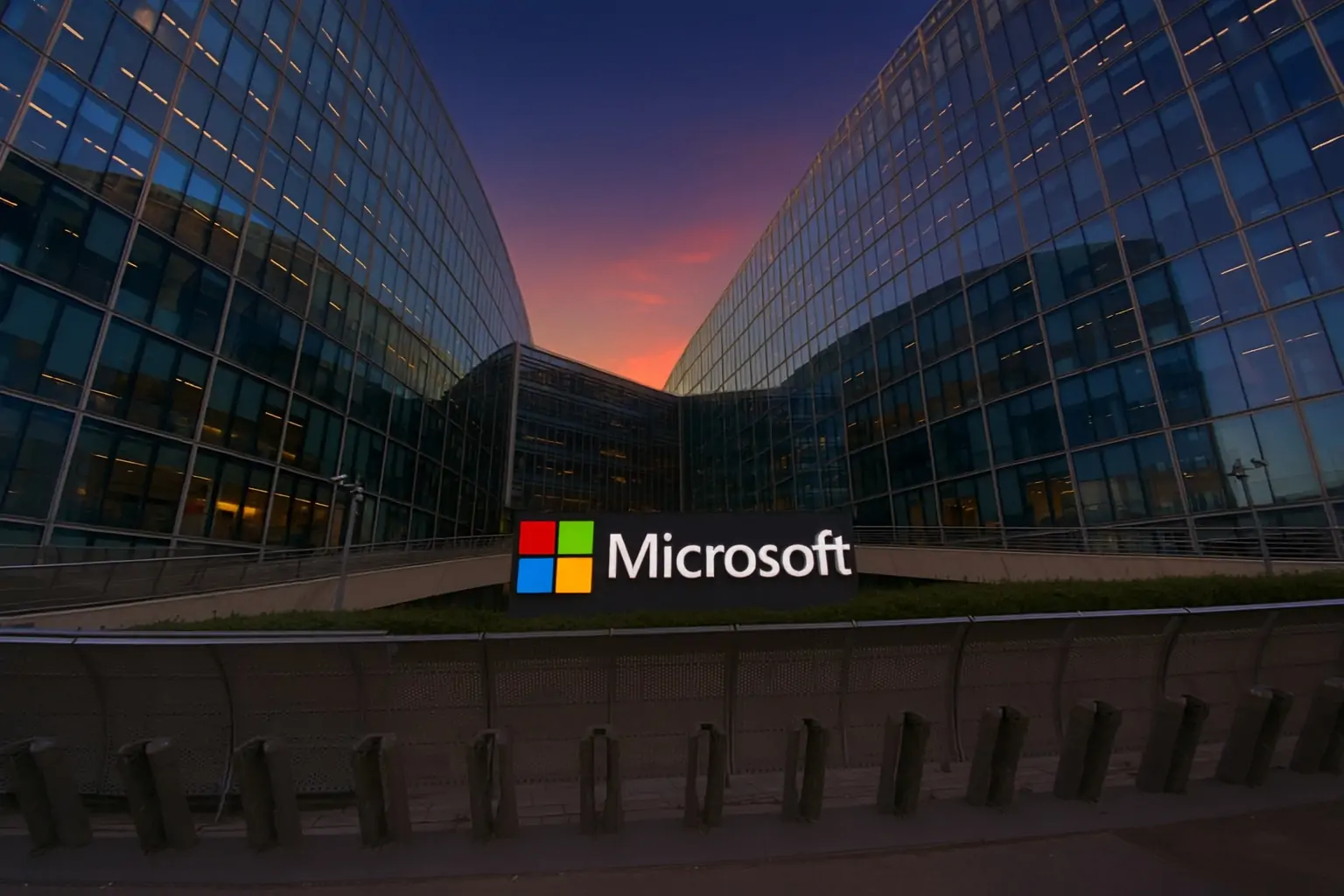Recent Developments and Market Momentum (November 2025)
Microsoft’s stock has been navigating a volatile November 2025 amid high expectations for artificial intelligence (AI) and cloud growth. After hitting a late-October closing peak around $542 per share, MSFT shares pulled back roughly 7–8% into mid-November [1]. In fact, the stock is enduring its longest losing streak in over a decade, with an 8.6% drop over eight sessions erasing nearly $350 billion in market value as investors grow cautious about a potential “AI-fueled valuation bubble” and heavy AI spending [2] [3]. This pullback, however, comes after a strong year – Microsoft remains up double digits year-to-date even after the recent slide [4], reflecting robust fundamentals despite short-term market jitters.
Broader tech sector pressures – from rising interest rates to questions about AI hype – have weighed on MSFT in recent weeks [5]. Major News: Microsoft and Amazon are backing proposed U.S. legislation (the GAIN AI Act) to curb exports of advanced Nvidia AI chips to China [6]. Microsoft’s support for tighter export controls underscores its alignment with U.S. policy on AI infrastructure [7]. While such restrictions could channel more AI cloud demand to U.S.-based providers like Microsoft Azure, they also risk denting Nvidia’s growth narrative – a factor that can ripple across all AI-exposed stocks, including Microsoft [8]. Investors are closely watching upcoming Nvidia earnings and guidance as a barometer for the sustainability of the AI spending boom [9].
On the positive side, Microsoft is doubling down on next-generation AI capabilities. The company unveiled a “planet-scale” AI supercomputer project – a massive cloud infrastructure linking datacenters in different regions with hundreds of thousands of cutting-edge Nvidia GPUs – to train advanced AI models faster and more efficiently [10]. This “AI superfactory” initiative highlights Microsoft’s commitment to being a core “picks-and-shovels” provider for the AI boom [11]. At the same time, Microsoft’s quarterly capital expenditures on AI and cloud have climbed toward an eye-popping $35 billion, putting the company front-and-center in debates about an AI investment bubble [12]. Another headline in focus: recent reports revealed a renegotiated partnership with OpenAI, freeing Microsoft to pursue its own artificial general intelligence (AGI) projects after years of exclusivity (more on this below) [13] [14]. Overall, despite short-term stock volatility, Microsoft’s latest moves underscore its aggressive push into AI and cloud – setting the stage for continued growth as well as higher scrutiny of spending and valuation.
Robust Earnings Fuel Optimism (Q3–Q4 FY2025 and Q1 FY2026)
Microsoft’s financial performance in 2025 has been strong, powered by its cloud and AI businesses. The company closed out fiscal year 2025 with blowout Q4 results (quarter ended June 30, 2025) that exceeded Wall Street expectations. Revenue in Q4 FY25 was $76.4 billion – up 18% year-over-year – while diluted earnings per share of $3.65 beat analyst forecasts of ~$3.37 [15] [16]. Net income for the quarter jumped 24% YoY to $27.2 billion [17] [18]. The earnings beat was driven by surging cloud demand (Azure and other cloud services revenue grew ~39% in the quarter) and the broad adoption of AI-powered offerings across Microsoft’s portfolio [19] [20]. Following the Q4 announcement in July, Microsoft’s stock saw a modest bump – reflecting that much of the good news was already priced into shares near all-time highs [21].
Key Takeaways – Recent Earnings:
- Q4 FY2025 (Apr–Jun 2025): Revenue came in at $76.4 billion (up 18% YoY) with EPS of $3.65 (up 24%), handily beating estimates [22] [23]. Operating income grew 23% YoY, showcasing strong operating leverage. Microsoft Cloud revenue reached $46.7 billion in the quarter (up ~27% YoY), fueled by Azure’s growth and AI services [24] [25]. Azure’s annualized revenue topped $75 billion, up 34% year-over-year, highlighting Microsoft’s cloud dominance [26]. Microsoft returned $9.4 billion to shareholders via buybacks and dividends in Q4 [27].
- FY2025 Full-Year: Revenue totaled $281.7 billion (+15% YoY) with net income of $101.8 billion (+16%) for the fiscal year [28]. This marks Microsoft’s first year crossing the $100 billion profit milestone. The company has now increased its dividend for 19 consecutive years [29] – including a recent 10% hike to a quarterly payout of $0.91 per share (announced in Sept. 2025) [30] [31].
- Q1 FY2026 (Jul–Sep 2025): Momentum carried into the new fiscal year. First-quarter FY26 revenue hit $77.7 billion (+18% YoY) – Microsoft’s highest quarterly revenue ever, and an acceleration in growth – with adjusted EPS of $4.13 beating expectations (GAAP EPS $3.72, up 13%) [32] [33]. Operating income jumped 24% YoY in Q1 FY26 [34]. Notably, Azure and other cloud services grew 40% YoY last quarter [35] [36], even faster than the prior quarter’s pace, thanks to booming demand for AI workloads. CFO Amy Hood said Microsoft “exceeded expectations across revenue, operating income, and EPS” to start the year [37] [38].
These results underscore that AI is not just hype for Microsoft – it’s translating into real revenue and profit growth. Satya Nadella, Microsoft’s CEO, noted that “we are going through a generational tech shift with AI”, emphasizing that cloud/AI adoption is still in “early innings” with plenty of room to run [39]. One cautionary note: Microsoft’s record AI investments are pressuring margins slightly. The company’s gross margin ticked down as it scaled up AI infrastructure, and it took a $3.1 billion charge in Q1 FY26 tied to its OpenAI investment [40] [41]. Nonetheless, operating margins remain robust and free cash flow surged 33% in Q1, indicating Microsoft can invest heavily in AI while still growing its bottom line [42].
Wall Street’s reaction to earnings has been somewhat measured. Microsoft’s stock popped over 7% after its FY25 Q3 earnings beat in April [43] [44], and shares initially rose after the strong Q4 FY25 report [45]. However, following the Q1 FY26 beat in late October, MSFT stock slipped about 4% in after-hours trading [46]【27†L59-L67】. The dip reflected profit-taking and the fact that investor expectations were already sky-high – the in-line guidance for the December quarter (Azure ~37% growth and roughly flat operating margins YoY) wasn’t enough to push the stock higher [47]. In short, Microsoft’s financial trajectory is very strong, but the stock’s rich valuation means each earnings report is under a microscope.
AI Initiatives and Cloud Business Drive Growth
Microsoft’s cloud segment (Azure) continues to be the primary growth engine. In the latest quarter, Intelligent Cloud revenue jumped 28% YoY to $30.9 billion [48], with Azure and other cloud services up 40% – an acceleration attributable to surging AI-related workloads and new product adoption [49] [50]. Azure’s growth is so rapid that Microsoft has been running up against capacity constraints. The company disclosed that demand for its AI cloud services exceeds supply in some areas, even after hefty infrastructure additions [51]. Microsoft expects to remain “capacity constrained” in Azure through at least the end of FY2026 due to insatiable AI demand, and it is racing to add data centers, GPUs, and network capacity [52] [53]. In Q1 alone, Microsoft’s capital expenditures swelled to roughly $35 billion – an all-time high – as it pours money into AI hardware to meet customer needs [54] [55].
Crucially, this massive investment is backed by clear signs of sustained demand. Microsoft’s commercial cloud backlog (remaining performance obligation) has exploded to $392 billion, up 51% year-over-year [56] [57], indicating customers have committed to almost $400 billion in future Azure and cloud services – a huge vote of confidence in Microsoft’s platform. Much of this backlog growth comes from organizations signing long-term AI and cloud deals. For instance, OpenAI – whose popular ChatGPT is built on Azure – recently agreed to spend $250 billion on Microsoft’s cloud through 2032 as part of an expanded partnership [58]. Microsoft’s CFO noted “demand is increasing… across many places,” with rapid uptake of new AI features like Copilot for Microsoft 365 driving additional cloud usage [59] [60].
Beyond raw cloud capacity, Microsoft is integrating AI across its product portfolio to fuel growth. The company’s Microsoft 365 Copilot (an AI assistant integrated into Office apps) launched to enterprise customers, contributing to a 17% jump in commercial cloud revenue for the Productivity segment [61]. Consumer subscriptions are also benefitting – Microsoft 365 Consumer cloud revenue leapt 26% as new AI features rolled out [62]. CEO Nadella describes Microsoft’s strategy as building a “planet-scale cloud and AI factory” that delivers Copilots and AI services across high-value domains [63]. In practice, that means AI enhancements in everything from GitHub coding tools to Dynamics 365 business software, driving usage and subscription growth. LinkedIn, too, is seeing AI-driven engagement, with revenue up 9–10% despite a softer hiring market [64].
It’s worth noting that Microsoft’s AI ambition extends to custom silicon and advanced research. With AI workloads booming, Microsoft has reportedly been developing its own AI chips (to reduce reliance on Nvidia) and investing in specialized startups. The new “AI Supercomputing” team under Mustafa Suleyman (CEO of Microsoft’s AI division) is tasked with building frontier AI models in-house – essentially aiming for artificial general intelligence developed by Microsoft itself [65] [66]. This marks a strategic shift: under the old OpenAI deal, Microsoft was barred from pursuing its own AGI until 2030, but that restriction has now been lifted [67]. Microsoft is now free to compete directly in cutting-edge AI model development, putting it in the ring with Google’s DeepMind, Meta, and others [68]. This move reinforces Microsoft’s positioning as a long-term AI leader, though it also means higher R&D costs and new execution risks as the company takes more of the AI stack in-house.
Strategic Acquisitions and Partnerships
Microsoft’s strategic deals in recent years are bearing fruit, further strengthening its competitive moat:
- OpenAI Partnership Revamped: Microsoft’s relationship with OpenAI deepened in 2025. The companies renegotiated their agreement such that Microsoft invested further in OpenAI (now owning an estimated 27% stake in OpenAI’s for-profit arm) and secured extended access to OpenAI’s latest models through 2032 [69]. In return, OpenAI committed to ~$250 billion of Azure cloud usage over the next several years [70]. Notably, Microsoft dropped its exclusivity rights, meaning OpenAI can use other clouds and Microsoft can develop its own AI models without constraints [71] [72]. This win-win deal effectively anchors Microsoft’s AI cloud business with a massive guaranteed workload (OpenAI’s spend underwrites ongoing Azure expansion), while freeing Microsoft to explore new AI frontiers independently. It also signals Microsoft’s confidence in the long-term value of AI – valuing OpenAI at around $135 billion in the process [73].
- Activision Blizzard Acquisition: In October 2023, Microsoft completed its $68.7 billion acquisition of gaming giant Activision Blizzard. Now, a year later, the integration is bolstering Microsoft’s gaming business. Xbox content and services revenue jumped 16% year-over-year in fiscal 2025 “driven by the impact of the Activision Blizzard acquisition and Xbox Game Pass” subscriptions [74]. Flagship Activision franchises like Call of Duty, Diablo, and Overwatch have been added to Microsoft’s Xbox Game Pass service, making the platform more attractive to gamers. Microsoft has honored commitments to keep hit games available on rival consoles (e.g. Sony PlayStation) while also leveraging the vast game library to strengthen its cloud gaming and subscription offerings [75] [76]. This acquisition not only provides new revenue streams (Activision contributed to 9% gaming revenue growth in FY25 [77]) but also positions Microsoft as a dominant content player in the $200+ billion gaming industry, supporting its long-term strategy of growing Xbox engagement and monetization.
- Cloud Partnerships: Microsoft has also been forging alliances to expand Azure’s reach. For example, it struck deals with enterprise software firms and cloud operators to ensure Azure is the backbone for many AI startups and services. In early November, Microsoft announced multi-billion-dollar cloud collaborations – a $9.7 billion deal with data-center operator IREN and a big GPU deployment partnership with AI startup Lambda – both aimed at easing the global shortage of AI compute capacity by using Azure [78]. Microsoft is also collaborating with Anthropic (an AI firm backed by Google) to provide infrastructure for Anthropic’s AI models under a $50 billion plan [79]. Moreover, Microsoft’s long-standing partnership with Oracle (interconnecting Azure and Oracle’s cloud databases) continues to attract enterprise clients in multi-cloud scenarios. These strategic partnerships and integrations reinforce Azure’s position as a versatile, go-to cloud platform, whether for Fortune 500 companies or cutting-edge AI startups.
In summary, Microsoft’s M&A and partnership strategy – from swallowing a gaming titan to aligning with AI innovators – is expanding its ecosystem and competitive advantage. These moves provide new growth vectors (gaming, content, AI services) while locking in future cloud revenue.
Analyst and Investor Sentiment
Despite the recent dip from record highs, Wall Street remains broadly bullish on Microsoft. The consensus analyst view is “Buy”, supported by strong fundamentals in cloud and AI. On November 14, Baird initiated coverage of MSFT with an “Outperform” rating and a $600 price target, citing Microsoft’s leadership in AI and diversified revenue streams [80]. FactSet’s compilation shows the average 12-month price target is around $630 per share, with numerous analysts raising targets after the latest earnings beats [81]. For instance, a recent 24/7 Wall St. outlook set a one-year target of ~$563 (about 10% above mid-November levels), highlighting Azure’s strength but also acknowledging heavy AI capex and potential supply constraints as factors to monitor [82]. Morningstar similarly values Microsoft in the $600 range, noting its “wide moat” and resilient cloud franchise. Notably, some high-end bullish scenarios see MSFT reaching $700 in the next year or two, while the lowest analyst targets are in the low-$400s – indicating generally optimistic sentiment with a few cautionary voices [83] [84]. Overall, the analyst consensus is that Microsoft’s AI-driven growth can justify further stock gains, though the stock’s premium valuation means any disappointment could trigger volatility.
Institutional investors have mostly maintained or increased their positions, even as a few take profits. Recent SEC filings (13F disclosures for Q2 2025) show a mixed but positive picture: funds like Harbor Asset Planning initiated new positions in Microsoft, and Omnia Family Wealth boosted its stake by 7.4% in the quarter [85]. On the other hand, some long-term holders trimmed exposure – Hourglass Capital cut its MSFT stake by about 4.4%, and Rockbridge Capital Management sold a block of shares, likely locking in gains after the big rally [86]. Insider trading has also drawn attention. CEO Satya Nadella sold a large chunk of Microsoft stock (at an average price near $505) earlier in 2025 [87], a move that coincided with the stock’s peak levels. Such insider sales are not unusual for mega-cap tech executives (who often diversify their holdings), but traders do take note when insiders sell into strength [88]. Importantly, Microsoft’s institutional ownership remains very high – the stock is a staple in many portfolios – and recent transactions suggest some investors are rotating (taking some profits) while others are buying the dip [89]. Retail investor sentiment, influenced by outlets like The Motley Fool and Nasdaq.com, also views Microsoft’s pullback as a potential “buy-the-dip” opportunity given the company’s long-term prospects [90].
In short, the smart money largely agrees that Microsoft’s AI and cloud trajectory is intact. The near-term caution (due to valuation and macro factors) is balanced by long-term optimism. This dynamic was summed up by one market observer as “long‑term optimism with near‑term caution”, as investors weigh Microsoft’s enormous AI upside against its high multiples and spending levels [91].
Valuation and Peer Comparison
Microsoft’s stock currently trades at a premium valuation relative to both the market and many peers, reflecting its strong growth and dominant position in key tech segments. As of mid-November 2025, MSFT’s price-to-earnings (P/E) ratio (trailing twelve months) hovers around 35–36× earnings [92]. This is well above the S&P 500 average (approximately 20× in late 2025) and even above some fellow “Big Tech” giants. For comparison, Alphabet (Google) trades around 28× earnings and Amazon about 33.5×, while Apple’s P/E is similar to Microsoft’s at roughly 36.5× [93]. In other words, Microsoft and Apple are valued on the higher end of the spectrum, whereas Google is seen as relatively cheaper at current prices. Part of this premium stems from Microsoft’s consistency and diversified model – it’s a rare $3–4 trillion company still growing revenues ~15–20% yearly, with a fortress balance sheet and multiple growth engines (cloud, AI, software, gaming). Additionally, Microsoft’s margins and cash flows are best-in-class, supporting a nearly 70% gross margin and steady shareholder returns [94].
However, the rich valuation also implies high expectations. Microsoft’s forward P/E will depend on its earnings growth in 2026; analysts do anticipate double-digit earnings growth ahead (consensus sees ~23% EPS growth in 2025 and strong growth beyond) [95], which could bring the forward multiple down somewhat. Even so, valuation is a key debate: some skeptics warn that a 35× multiple is hard to sustain indefinitely unless Microsoft keeps delivering big growth surprises. Microsoft’s P/E is not only above the market average but also above the tech sector median (the industry median P/E is around 29.7) [96]. If interest rates remain elevated or if AI spending growth moderates, highly valued stocks like MSFT could see multiple compression. Microsoft’s management appears mindful of this – the company is continuing to grow profits (operating income up 17%+ in FY25 [97]) even as it spends heavily on AI, aiming to prove that the investment is yielding commensurate returns.
In comparison to peers: Google (Alphabet) is often cited as undervalued relative to Microsoft – if Alphabet had Microsoft’s multiple, its market cap would be far higher [98]. Alphabet’s slower revenue growth (closer to 10% recently) and higher regulatory risk partly explain the gap. Amazon, which is also investing heavily in AI and has a booming cloud unit (AWS), trades around 33× earnings; Amazon’s valuation has climbed as its profitability improved, but it’s still slightly below MSFT despite Amazon’s higher risk profile in e-commerce. Apple, a more hardware-driven business with single-digit revenue growth, commands ~36× earnings largely due to its brand and shareholder loyalty – a sign that in this market, investors reward reliable cash generation and ecosystem strength. Microsoft fits that bill and then some, which is why it enjoys a premium.
Bottom line: Microsoft is not a “cheap” stock by conventional metrics, but investors thus far have been willing to pay up for its dominant position in cloud and AI. The company’s ability to sustain ~double-digit growth at such scale justifies a higher multiple than the average stock. If Microsoft continues executing (growing Azure, monetizing AI features, expanding margins gradually), many analysts argue its valuation is reasonable. But if cracks appear – e.g. AI growth slows or margins erode more than expected – MSFT’s premium could be at risk, leading to stock volatility [99]. For now, Microsoft’s valuation versus peers reflects its status as arguably the leader of the tech pack going into 2026, alongside Apple, while Google and others trade at discounts that might narrow if they close the AI gap.
Stock Forecast – Near-Term and Long-Term Outlook
Near-Term (Weeks to Months): In the coming weeks and months, Microsoft’s stock trajectory will likely be influenced by broader market sentiment and a few key catalysts. The overall setup for late 2025 is cautious optimism. On one hand, tech stocks including MSFT remain under pressure from macro factors – investors are still weighing the risk of an “AI bubble” and the impact of high interest rates on equity valuations [100]. Any news that questions the longevity of the AI spending boom (for example, if a major customer scales back, or if a competitor issues a warning) could spark further profit-taking. Additionally, Microsoft’s own commentary of massive capex means some near-term earnings moderation; the company guided for roughly flat operating margins in the holiday quarter due to seasonal expenses and continued AI investments [101] [102]. These factors may keep MSFT shares range-bound or slightly volatile into year-end.
On the other hand, positive drivers are evident: Microsoft’s fundamentals are strong, and the stock’s recent dip has made its valuation a bit more palatable than a month ago. Short-term traders are watching whether MSFT can stabilize around the $500 level and resume its uptrend relative to the Nasdaq [103]. A major near-term catalyst is earnings from Nvidia (due in late November 2025) – blowout results or guidance from Nvidia (the bellwether of AI hardware demand) could reignite enthusiasm for all AI plays, Microsoft included [104]. Conversely, any sign of AI demand cooling could temporarily weigh on sentiment. Also, the Federal Reserve’s stance on interest rates will play a role; signs of easing inflation or a pause in rate hikes would be bullish for high-growth tech stocks. Seasonally, late Q4 can be favorable for tech if holiday spending and enterprise budgets remain solid. Microsoft’s next earnings (FY26 Q2 results, expected in late January 2026) will be closely watched for the Azure growth rate and any update on AI capacity expansion – those will shape the stock’s early 2026 direction.
Most analysts still see upside into early 2026. Price targets imply that MSFT could climb back toward the mid-$500s or higher over the next 3–6 months [105], assuming no major negative surprises. In the near term, support levels in the high-$400s (around $490) could attract buyers, while the previous high ~$540 is the first upside hurdle to clear. If Microsoft delivers another quarter of 35%+ Azure growth and confident guidance, it’s plausible the stock retests its highs. In summary, for the next few months Microsoft’s stock forecast is for moderate gains with volatility, contingent on AI demand remaining red-hot and the broader market cooperating.
Long-Term (2026 and Beyond): Looking further out, Microsoft’s outlook remains robust. The company itself projects double-digit revenue and operating income growth in FY2026, building on FY2025’s strong results [106]. Azure is expected to grow at least in the mid-30% range in the near term, and potentially sustain 20%+ annual growth over a multi-year horizon given the low penetration of cloud/AI in many industries. Microsoft’s entrenched position in enterprise software (Windows, Office, Azure, GitHub, etc.) gives it unparalleled distribution for new AI offerings – which could translate to significant new revenue streams by 2026–2027 (e.g. from Microsoft 365 Copilot subscriptions, Azure OpenAI services, and even AI-driven advertising or security services).
Wall Street analysts broadly anticipate Microsoft will continue to outperform the broader market in the coming years. Many have 2030 outlooks that see Microsoft at substantially higher revenues and earnings, underpinned by AI. For instance, if Azure and cloud-related businesses maintain momentum, Microsoft could approach or exceed $400 billion in annual revenue by FY2028–2029, according to some bullish estimates. Long-term price targets are inherently uncertain, but it’s telling that even relatively conservative fair value estimates (like Morningstar’s) are around $600, and more optimistic analysts see Microsoft’s market cap pushing well beyond $4 trillion (which it briefly touched in 2025) in the next couple of years [107]. Achieving that would likely require MSFT stock trading in the $600–$650 range, roughly 20–30% above current levels. Key drivers for such growth include: continued AI adoption across industries, expansion of cloud market share (Azure closing the gap with AWS), growth in high-margin subscription services, and successful integration of gaming/content to boost consumer revenues.
Risks to the long-term forecast do exist. Intensifying competition in cloud (from Amazon, Google, and Oracle) could pressure Azure’s growth or margins. Regulatory challenges are another factor – Microsoft, like other Big Tech firms, faces antitrust scrutiny that could potentially limit future acquisitions or business practices (though so far Microsoft has navigated regulators better than some peers, e.g., successfully closing the Activision deal). There’s also execution risk in Microsoft’s enormous bet on AI: the company is spending tens of billions on infrastructure ahead of revenue, counting on rising demand. If the AI boom were to slow unexpectedly, Microsoft could be left with excess capacity. Moreover, as Microsoft steps into developing its own AI models, it competes more directly with the likes of Google’s DeepMind and OpenAI’s other backers – meaning it must attract top talent and achieve breakthroughs to stay at the cutting edge.
That said, Microsoft’s track record over the past decade – transitioning to cloud, mastering enterprise sales, and now leading in AI adoption – gives confidence in its long-term trajectory. The company’s diversified empire (productivity software, cloud, AI, gaming, LinkedIn, etc.) provides resilience; weakness in one area (say PC Windows sales) is often offset by strength elsewhere. Institutional investors like pensions and endowments often view Microsoft as a core long-term holding, given its consistent growth and shareholder-friendly policies (share buybacks, rising dividends) [108]. As long as Microsoft executes on the massive AI opportunity and maintains its competitive advantages, the long-term forecast is for steady growth in revenue and earnings through 2026 and beyond, likely translating into a higher stock price over time.
Conclusion: Microsoft enters 2026 as one of the world’s most valuable and innovative companies, riding a wave of AI and cloud computing demand. Recent news – from record earnings to big strategic moves in AI – reinforces the narrative that Microsoft is a prime beneficiary of the digital transformation era. In the near term, the stock may ebb and flow with investor sentiment on tech and AI spending. But the core fundamentals are strong: Microsoft’s cloud is growing at nearly 40% [109], its balance sheet is rock-solid, and its leadership in AI (via products like Copilot and partnerships with firms like OpenAI) positions it at the forefront of the next tech revolution. Analysts remain largely bullish, and Microsoft’s own guidance points to confident growth ahead [110]. Barring unforeseen shocks, Microsoft’s stock is expected to trend upward over the next year, with the potential to reach new highs as AI initiatives bear fruit. Long-term investors view MSFT as a cornerstone holding to “own AI, not just ride the hype,” given the company’s tangible earnings power behind the AI story. As always, investors should monitor upcoming earnings, Azure growth metrics, and spending levels – but as of November 2025, Microsoft’s outlook appears bright, with AI and cloud fueling the next leg of its growth [111] [112].
Sources: Microsoft Investor Relations (earnings releases) [113] [114]; Investing.com earnings summary [115] [116]; TS² Tech market analysis [117] [118]; Reuters and Economic Times reports [119] [120]; Microsoft annual report 2025 [121]; Quartz and Insider coverage [122] [123]; FinanceCharts P/E data [124]; Microsoft News releases [125].
References
1. ts2.tech, 2. ts2.tech, 3. economictimes.indiatimes.com, 4. ts2.tech, 5. ts2.tech, 6. ts2.tech, 7. ts2.tech, 8. ts2.tech, 9. ts2.tech, 10. ts2.tech, 11. ts2.tech, 12. ts2.tech, 13. ts2.tech, 14. ts2.tech, 15. www.investing.com, 16. www.investing.com, 17. www.microsoft.com, 18. www.microsoft.com, 19. www.microsoft.com, 20. www.investing.com, 21. www.investing.com, 22. www.investing.com, 23. www.investing.com, 24. www.investing.com, 25. www.investing.com, 26. www.investing.com, 27. www.microsoft.com, 28. www.microsoft.com, 29. www.investing.com, 30. news.microsoft.com, 31. news.microsoft.com, 32. www.microsoft.com, 33. www.microsoft.com, 34. www.microsoft.com, 35. www.microsoft.com, 36. www.microsoft.com, 37. www.microsoft.com, 38. www.microsoft.com, 39. www.investing.com, 40. qz.com, 41. qz.com, 42. qz.com, 43. www.investopedia.com, 44. www.investopedia.com, 45. www.investing.com, 46. qz.com, 47. www.gurufocus.com, 48. www.microsoft.com, 49. www.microsoft.com, 50. qz.com, 51. www.gurufocus.com, 52. qz.com, 53. qz.com, 54. qz.com, 55. qz.com, 56. www.microsoft.com, 57. qz.com, 58. qz.com, 59. qz.com, 60. qz.com, 61. www.microsoft.com, 62. www.microsoft.com, 63. www.microsoft.com, 64. www.microsoft.com, 65. ts2.tech, 66. ts2.tech, 67. ts2.tech, 68. ts2.tech, 69. qz.com, 70. qz.com, 71. ts2.tech, 72. ts2.tech, 73. qz.com, 74. www.microsoft.com, 75. blogs.microsoft.com, 76. blogs.microsoft.com, 77. www.microsoft.com, 78. ts2.tech, 79. ts2.tech, 80. ts2.tech, 81. ts2.tech, 82. ts2.tech, 83. www.investing.com, 84. www.investing.com, 85. ts2.tech, 86. ts2.tech, 87. ts2.tech, 88. ts2.tech, 89. ts2.tech, 90. ts2.tech, 91. ts2.tech, 92. www.financecharts.com, 93. www.financecharts.com, 94. www.investing.com, 95. finance.yahoo.com, 96. www.financecharts.com, 97. www.investing.com, 98. www.nasdaq.com, 99. ts2.tech, 100. ts2.tech, 101. qz.com, 102. qz.com, 103. ts2.tech, 104. ts2.tech, 105. ts2.tech, 106. www.investing.com, 107. ts2.tech, 108. www.investing.com, 109. www.microsoft.com, 110. www.investing.com, 111. www.microsoft.com, 112. www.investing.com, 113. www.microsoft.com, 114. www.microsoft.com, 115. www.investing.com, 116. www.investing.com, 117. ts2.tech, 118. ts2.tech, 119. ts2.tech, 120. economictimes.indiatimes.com, 121. www.microsoft.com, 122. qz.com, 123. ts2.tech, 124. www.financecharts.com, 125. news.microsoft.com







